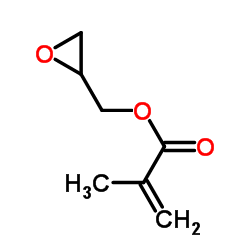We serve Glycidyl methacrylate CAS:106-91-2 to global customers since 2007, Pls send inquiry to info@nbinno.com or visit www.nbinno.com our official website should you have any interests. This site is for information only.

Chemical Name:Glycidyl methacrylate
CAS.NO:106-91-2
Synonyms:Glycidyl methacrylate
oxiran-2-ylmethyl methacrylate
2,3-epoxypropyl methacrylate
Methacrylic Acid Glycidyl Ester
Molecular Formula:C7H10O3
Molecular Weight:142.15200
Physical and Chemical Properties:
Density:1.075
Melting point:-52ºC
Boiling point:189ºC
Flash point:169°F
Index of Refraction:1.449
Specification:
Appearance:Colorless transparent liquid
Assay:≥98.0%
Moisture:≤0.05%
Color:≤50 APHA
Epichlorohydrin:≤500ppm
Cl:≤100ppm
Inhibitive substance:50-200ppm
Packing:200 kg/drum, can also be packaged according to customer requirements
Storage:Store in a cool, ventilated place
Application:(1)Mainly used in powder coating, thermosetting coating, fiber treatment agent, adhesive, antistatic agent, vinyl chloride stabilizer, rubber and resin modifier, ion exchange resin and adhesive for printing ink.
(2)Functional monomers used as polymerization. Mainly used in the manufacture of acrylic powder coatings, used as rigid monomer copolymerization with methyl methacrylate and styrene, adjustable glass temperature and flexibility, improve the coating gloss, adhesion and weather resistance. It is also used in the manufacture of acid and non-woven fabrics. As functional monomers, can be used in the manufacture of photosensitive resin, ion exchange resin, chelating resin, selective filtration membrane for medical, dental materials, anti coagulant, on soluble adsorbent etc. Also used for modify polyolefin resin, rubber and synthetic fiber.
(2)Because molecule contain carbon-carbon double bond and epoxy radical group, widely used in the synthesis and modification of polymer materials. Applicationd as reactive diluent of epoxy resin, stabilizer for vinyl chloride, rubber and resin modifier, ion exchange resin and adhesive for printing ink. Also used in powder coating, thermosetting coating, fiber treatment agent, adhesive, antistatic agent and so on. In addition, GMA also has a significant effect on the adhesion, water resistance and solvent resistance of the adhesive and non-woven fabrics.
(4)In electronics, for photoresist film, protective film, electronic wire, far infrared phase X-ray film. In functional polymer, used for ion exchange resin and chelating resin. In medical materials, for anti coagulation materials, dental materials.
Contact us for information like Glycidyl methacrylate chemical properties,Structure,melting point,boiling point,density,molecular formula,molecular weight,2,3-epoxypropyl methacrylate physical properties,toxicity information,customs codes,safety, risk, hazard and MSDS, CAS,cas number,oxiran-2-ylmethyl methacrylate Use and application,2,3-epoxypropyl methacrylate technical grade,usp/ep/jp grade.
Related News: The StartScore model was developed by the company’s in-house supply chain experts based on actual performance data.Dimethylbenzylcarbinyl Acetate manufacturer The upstream industry for the R & D, production and sales of pharmaceutical intermediates is the basic chemical raw material industry, and the downstream industry is the chemical bulk drug and chemical pharmaceutical preparation industry.Hexamethylcyclotrisiloxane supplier The company’s iPSC product platform unites stem cell biology and precision genetic engineering to create renewable master engineered iPSC lines that can be repeatedly used to mass produce cancer-fighting immune cells, replacing the high production costs, weeks of manufacturing time, and complex engineering processes required for current-generation CAR T-cell immunotherapies with an off-the-shelf product that has the potential to reach many more patients.2,4-Dimethyl-1-[(2-nitrophenyl)thio]benzene vendor But the ban from Italy remains, Joseph Wu, Taiwan’s foreign minister, said on Sunday.It does not require a production license for the drug substance, and can be produced in an ordinary chemical plant. As long as it reaches a certain level, it can be used for the synthesis of the drug substance.


